Join us for the launch of our final exhibitions of the season: THROUGH A MIRROR, DARKLY – a film commission from Turner-Prize nominated artist Naeem Mohaiemen and the 30th instalment of our Vitrines featuring a collection of photography from Baltimore-based photographer John Dean.
THROUGH A MIRROR, DARKLY is a new three-channel film by Turner Prize nominated artist Naeem Mohaiemen. It explores memorialisation, protest, and political violence through the lens of events in May 1970, when American students protesting domestic racism and overseas wars were met by state violence.
As part of the 30th instalment of our Bonington Vitrines series, we’re delighted to present A Semester in Nottingham, 1976, an exhibition of photographs by Baltimore-based John Dean. Captured during his time as a visiting student to NTU in 1976, these photographs offer a powerful glimpse into Nottingham life during a transformative era.
Enjoy a free welcome drink, delicious food (first come, first served!) and music.
All welcome but reserve your free ticket to avoid disappointment.
Join us for a free guided tour of Bonington Gallery’s latest exhibitions with BSL interpretation.
Book your free ticket and enjoy a guided tour of layt de kam, a solo exhibition by Ibiye Camp, led by the Gallery’s Director, Tom Godfrey.
Along with an introduction to the exhibition, Tom will talk through the accompanying Vitrines exhibition, Through Our Eyes, In Our Words.
This event will last up to an hour. Please meet inside Bonington Building in the foyer space outside the Gallery doors at 12.55 pm. Free and open to all, booking required.
Bonington Gallery presents A Semester in Nottingham, 1976, an exhibition of photographs by Baltimore-based John Dean. Captured during his time as a visiting student to Nottingham Trent University (NTU) in 1976, these photographs offer a powerful glimpse into Nottingham life during a transformative era.
This exhibition marks a poignant return to the institution — formerly Trent Polytechnic — where John studied as a visiting student nearly fifty years ago.
Armed with a camera and a quiet curiosity, John immersed himself in the rhythms of Nottingham life. Over the course of a single semester, he wandered the city’s streets and parks — Hyson Green, Market Square, the Arboretum — capturing striking black-and-white portraits of residents going about their daily lives. The resulting images are both documentary and deeply personal, offering a rare and intimate glimpse into the everyday lives of Nottingham’s people during a transformative era.
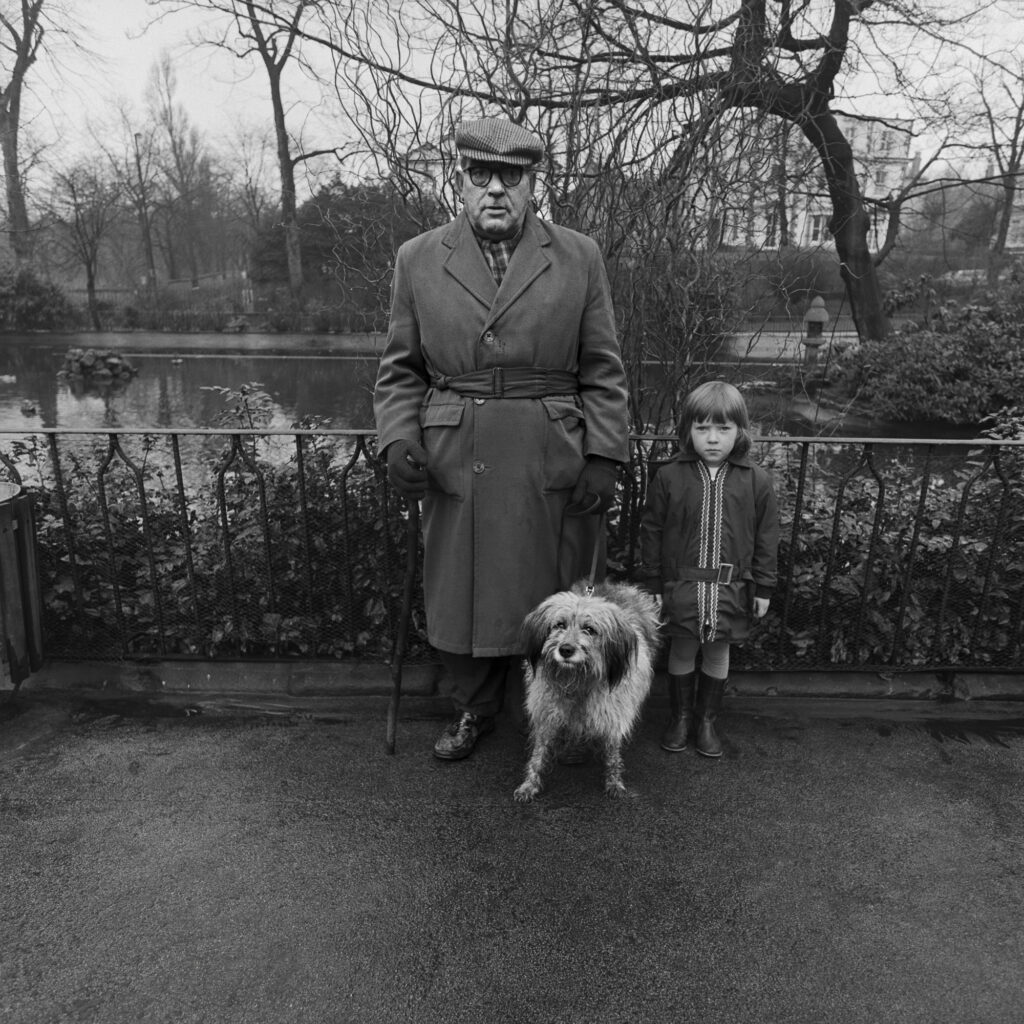
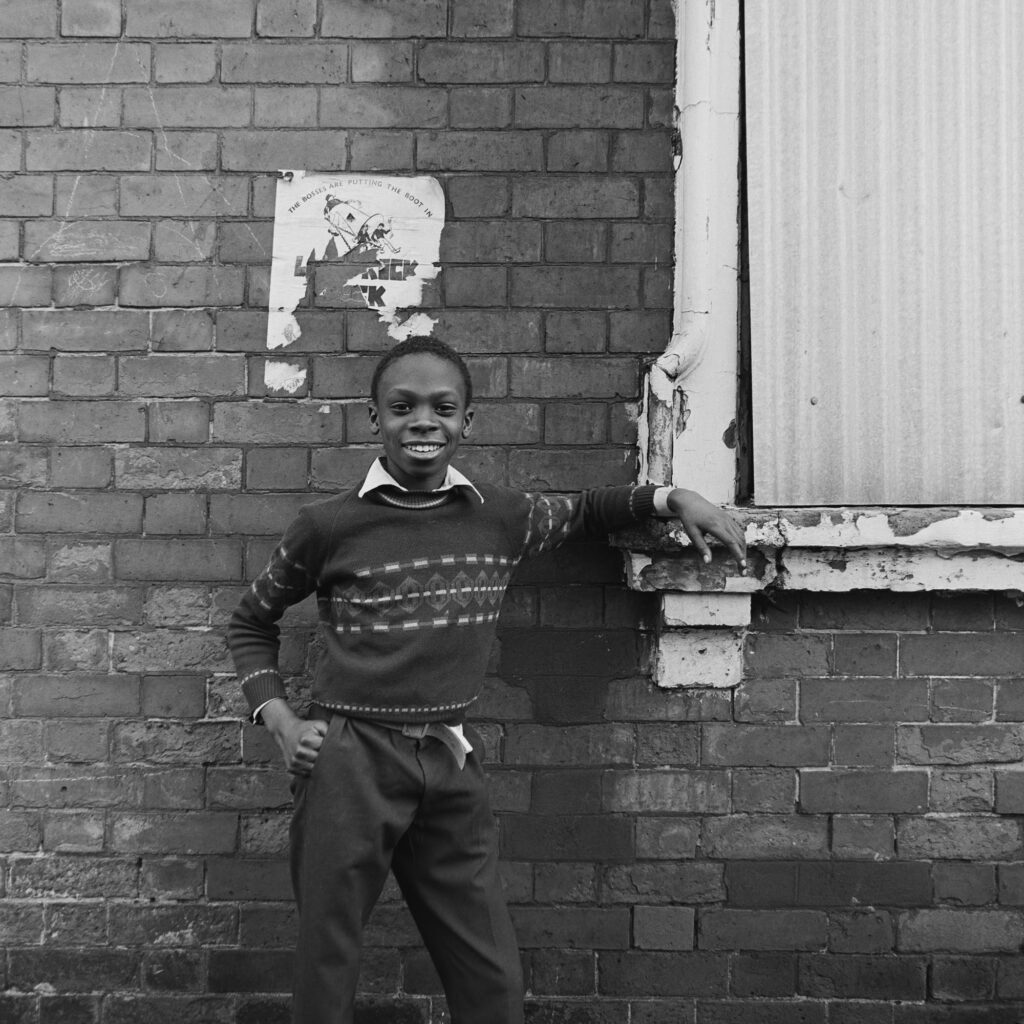
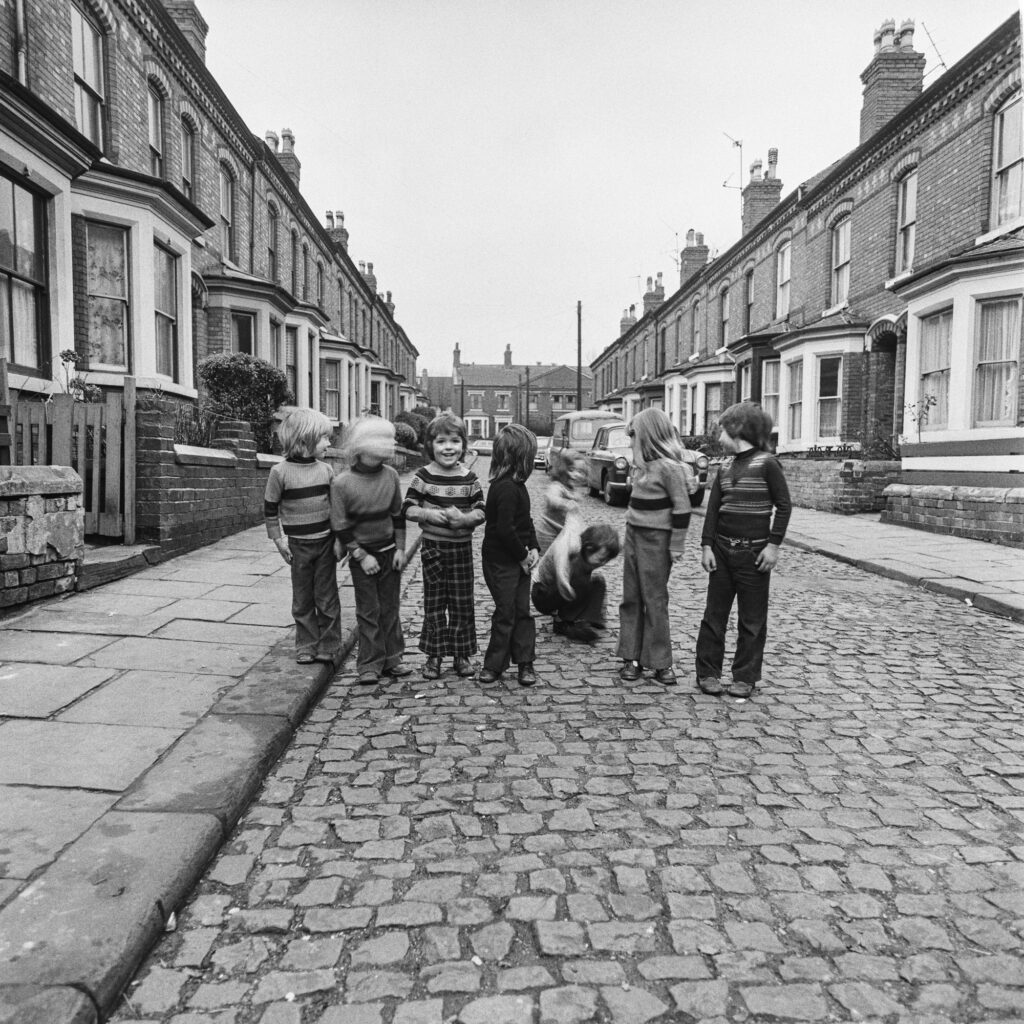
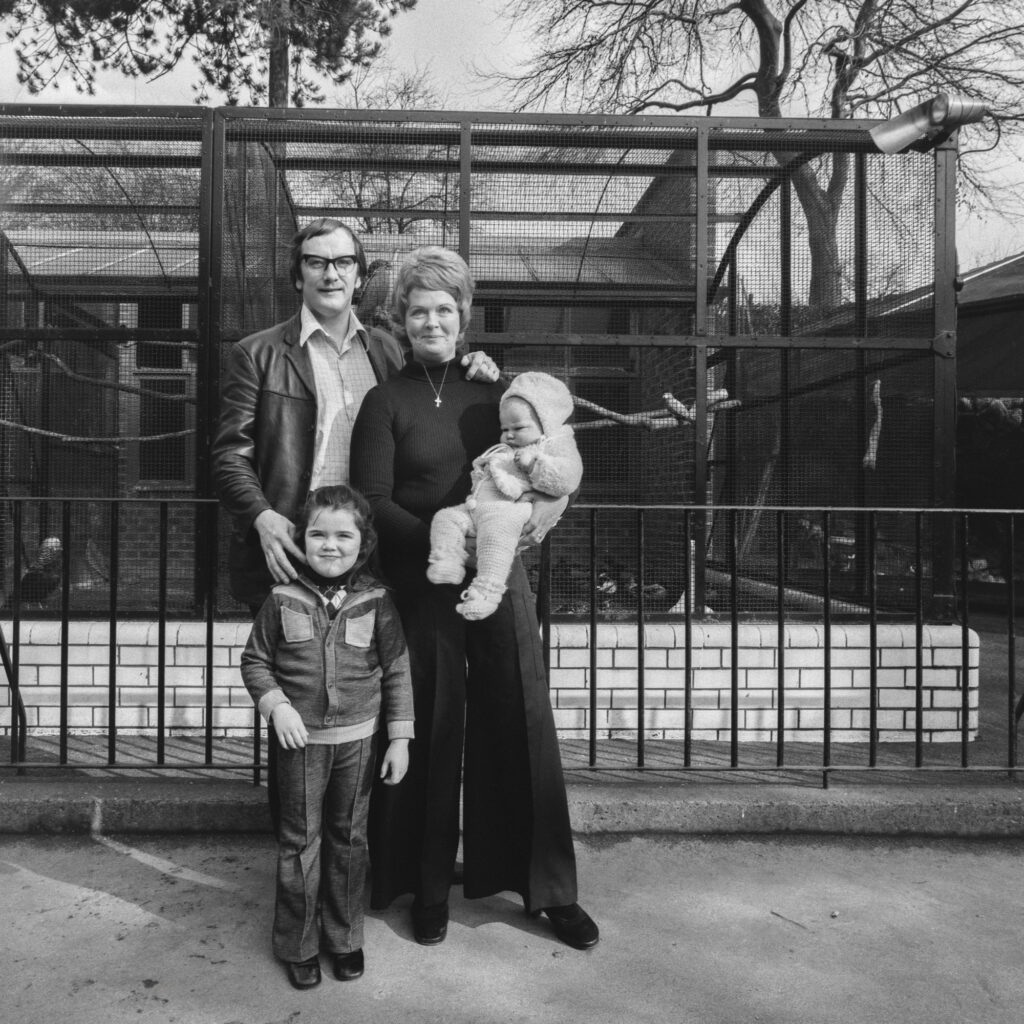
First developed in Trent’s own darkrooms (situated next door to the gallery), these photographs have remained largely unseen for decades. Now, they return to the place of their origin, standing as a testament to the power of observational storytelling, told through the eyes of a visitor to the city.
John has since built a distinguished career as a producer and videographer, creating historical and educational media for museums and non-profit organisations across the United States and beyond. Yet photography remains his first and most enduring creative language — a medium through which he continues to explore the intersections of memory, environment, and human experience.
John Dean is a Baltimore-based photographer, videographer who graduated with a BFA from the Maryland Institute College of Art. He regularly works with museums, non-profit organisations and editorial platforms on the creation of educational and historical media and content.
In addition to institutional work, John’s independent photographic practice has taken him across the world, exploring historic and cultural sites of significance, such as excavation sites in Greece and sacred spaces in Istanbul. As a long time mentor and arts advocate, John is consistently guided by a curiosity for human stories.
Join us for the launch of our latest exhibitions — a film and textile work by multi-disciplinary artist Ibiye Camp, exploring the complex interplay between infrastructure, care, and resilience along the coast of West Africa.
Layt de kam critically examines the deployment of temporary power ships along West African coasts as a response to energy shortages. The work reflects both hope and uncertainty, emphasizing the fragility of these energy solutions while honouring the resilience of coastal communities.
For the 29th instalment of the Bonington Vitrines series, we’re delighted to present Through Our Eyes, In Our Words, an exhibition presenting stories of ageing, belonging, and inclusion among middle-aged and older-aged LGBT+ people in Britain.
Enjoy a free welcome drink, delicious food (first come, first served!) and music.
All welcome but reserve your free ticket to avoid disappointment.
Bonington Gallery is pleased to present THROUGH A MIRROR, DARKLY, a new three-channel film by Turner Prize nominated artist Naeem Mohaiemen. The film explores memorialisation, protest, and political violence through the lens of events in May 1970, when American students protesting domestic racism and overseas wars were met by state violence.
As the Vietnam War came to its bloody end, for the American media, the memory of four American students shot dead at Kent State University was sometimes as emotionally charged as the millions of deaths in Vietnam.
In the decades that followed, a memorial community has formed around the ‘four dead in Ohio’. Yet while the deaths of students Alison Krause, Jeffrey Miller, Sandra Scheuer, and William Schroeder at Kent State, Ohio, are remembered, not many recall Phillip Lafayette Gibbs and James Earl Green, two students killed ten days later by police officers at Jackson State College, Mississippi, a Historically Black College.
By choreographing the relationship between archival footage and contemporary ceremonies memorialising the dead, THROUGH A MIRROR, DARKLY explores the role of memorials as a focal point for individual and collective grief. By comparing Kent and Jackson State, the project underscores blind spots around racialised violence and class tensions, made concrete in the disparity in coverage of these two campus shootings. The inclusion of stage-managed press conferences reveals the political machinations of the Nixon administration who fuelled a backlash to anti-war protests.
Mohaiemen deftly presents these intersecting strands, weaving together the voices of key political players, student leaders, and the fabled ‘man on the street’ alongside Vietnam veterans, to propose new interpretations of the events of May 1970 and their lasting impact.
“In Corinthians 13:12, ‘through a glass, darkly’ meant the impossibility of viewing the full scope of divine plans. In a more earthly, secular context, I consider the memorialization of the Vietnam War era, and how the farther away we get in years, the hazier the many meanings of events in the mirror of memory become.”
– Naeem Mohaiemen
THROUGH A MIRROR, DARKLY by Naeem Mohaiemen was commissioned by Artangel in partnership with Film and Video Umbrella and the Wexner Center for the Arts. It was first presented by Artangel at Albany House, London in September 2025.
Following the presentation at Bonington Gallery in March 2026, the film will travel to The Hunterian, Glasgow and John Hansard Gallery, Southampton.
Naeem Mohaiemen was born in London, UK, grew up in Dhaka, Bangladesh and currently lives and works in New York, USA. He combines films, photography, drawings, and essays to explore forms of utopia-dystopia within families, borders, architecture, and uprisings – beginning in South Asia and then radiating outward to transnational collisions in the Muslim world after 1945.
Several conversations around ‘nonalignment’ as a concept container in contemporary art pivoted after the premiere of his film Two Meetings and a Funeral (2017) at Documenta 14, which was nominated for the Turner Prize (2018).
Mohaiemen’s museum projects are represented by Experimenter Gallery (India) and film screenings are represented by LUX (UK); his work is in major international collections including British Museum and Tate Modern (London), Museum of Modern Art (New York), MACBA (Barcelona), Van Abbemuseum (Eindhoven), Kiran Nadar Museum (Delhi), National Gallery of Singapore, Art Institute of Chicago, Samdani Art Foundation and Sharjah Art Foundation.
Mohaiemen is co-editor with Eszter Szakacs of Solidarity Must Be Defended (Budapest, 2023) and with Lorenzo Fusi of System Error: War is a Force That Gives Us Meaning (Siena, 2007). He is the author of Bengal Photography’s Reality Quest (Dhaka, 2025), Baksho Rohoshyo (Umea, 2024), Midnight’s Third Child (Dhaka, 2023) and Prisoners of Shothik Itihash (Basel, 2014). He is a faculty member at the Visual Arts Department, Columbia University.
Bonington Gallery is delighted to present Through Our Eyes, In Our Words, an exhibition exploring stories of ageing, belonging, and inclusion among middle-aged and older-aged LGBT+ people in Britain.
What does it mean to belong? To grow older? To feel heard, seen, recognised?
Spanning LGBT+ History Month 2026, this exhibition from the IncludeAge project invites you to engage with the experiences of middle-aged and older-aged LGBT+ people in Britain today. Reflected through photographs, personal objects and testimony, LGBT+ people share what matters to them: the places they love and where they feel seen, and the everyday moments that shape who they are.
These artefacts don’t come from behind a lens held by someone else. They were taken by the people whose stories they tell. Some might identify as artists or creative practitioners, others not. Each photo and object is a choice – of what to show, how to show it, and what it means. Some speak of joy and celebration. Others quietly express frustration or longing—all of them reflect lives lived with strength, humour, creativity, and care.
The IncludeAge project (2022-26) explores experiences of inclusion and exclusion among diverse middle-aged and older aged people (40+), in physical places and online spaces..
The project specifically engages with LGBT+ individuals and people with learning disabilities. Its goal is to build on the insights shared by participants and use them to develop solutions that foster more inclusive communities.
The project is led by Professor Judith Sixsmith at the University of Dundee, in partnership with the University of Hertfordshire, Liverpool John Moores University, and the University of Edinburgh. Several organisations are also involved in the project, including Tonic Housing, Sleeping Giants, and Outside the Box, among others.
At Bonington during LGBT+ History Month 2026, Through Our Eyes / In Our Words showcases the richness of LGBT+ voices, histories, and imagery emerging through the project. Exhibitions elsewhere in the country will showcase material relating to the participants with learning disabilities.
For more information, please contact Dr Richard Vytniorgu (r.vytniorgu@herts.ac.uk).
Photo: Rosie Gardener
Bonington Gallery is delighted to announce layt de kam, a newly commissioned body of film and textile work by multi-disciplinary artist Ibiye Camp, exploring the complex interplay between infrastructure, care, and resilience along the coast of West Africa.
At the heart of the exhibition is a critical reflection on the deployment of temporary power ships off the coasts of various West African cities — an intervention intended to address unstable energy infrastructures and shortages. The title, layt de kam (translated as “light is coming”), evokes both hope and uncertainty, highlighting the precarity of such power solutions while celebrating the enduring strength of coastal communities.
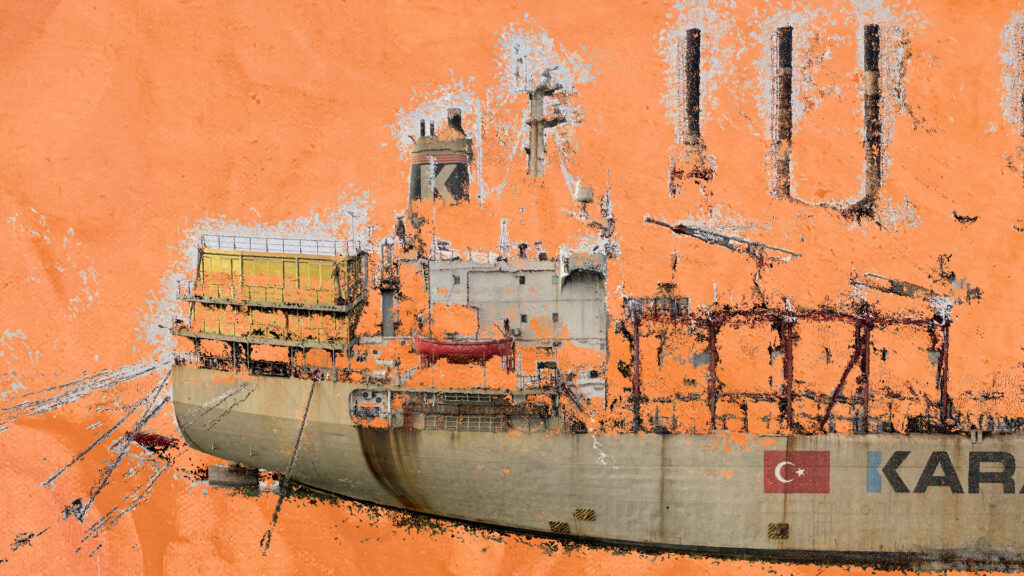
Combining spatial intervention, film and textiles, the exhibition will examine how brutalist infrastructure looms ominously over the intimate and everyday life on the shore. Central to the exhibition is a new film, GLOW, a speculative child’s tale that imagines the arrival of this foreign visitor who brings light. Created using point cloud reconstructions, the trace of the landscape is dependent on illumination, shadows and reflections to create the shapes and forms.
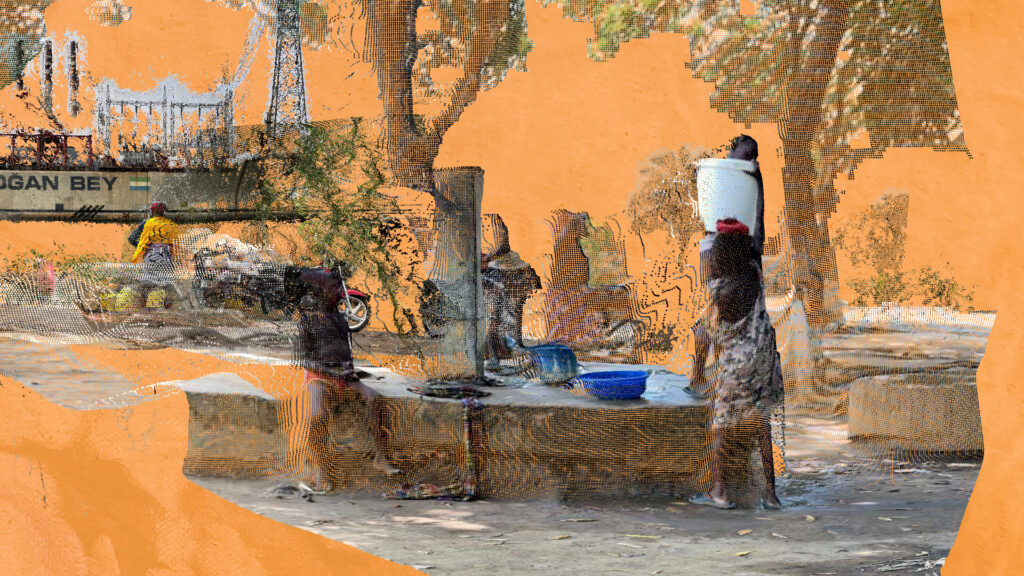
Camp further translates these digital landscapes into tactile form by laser-cutting point cloud stills into Kola Nut-dyed fabric. This process embeds the digital with the material, using concentrated light to cut cloth traditionally used by mothers to wrap their children—an enduring symbol of care and ancestral knowledge.
layt de kam further interrogates the broader geopolitical implications of temporary power infrastructures. Shaped by deregulation, privatisation, and conflict, these systems often reinforce global dependencies rather than fostering self-sufficiency. Drawing on theorist Keller Easterling’s concept of “extrastatecraft,” Camp reveals how non-state actors influence through infrastructure, turning energy access into a site of control.
By transforming disrupted landscapes into material memory, layt de kam offers a powerful narrative of resistance, care, and the entanglement of light, technology, and power.
Sound artist FAUZIA has made the soundtrack to Ibiye’s film GLOW.
Ibiye holds an MA in Architecture from the Royal College of Art, and BA (Hons) in Fine Art, from the University of the Arts London, Central Saint Martins. Ibiye’s Thesis project titled Data: The New Black Gold was awarded the School of Architectures Dean’s Prize and was nominated for the RIBA Silver Medal Award.
Ibiye has presented her work at The Sharjah Architecture Triennial titled Rights of Future Generations in 2019 and Triennale Milano The State of the Art of Architecture conference in 2020. She showed in the Istanbul Biennial titled Empathy Revisited in 2020, and MAAT – Museum of Art, Architecture and Technology’s exhibition titled X is Not a Small Country in 2021 and the 13th Shanghai Biennale titled Bodies of Water in 2021, and London’s Art Festival, Deptford X in 2022. In 2023 Ibiye was included in the Venice Architectural Biennial within the group exhibition Guests from the Future, and in 2024, was included in Unseen Guests, a project organized by Iniva as part of the British Pavilion’s public programme at the 60th Venice Biennial.
Ibiye Camp, Rhiarna Dhaliwal and Emmy Bacharach run a BA Studio titled Digital Native at the Design Academy Eindhoven.
Join us for the launch of the first exhibition of the academic year, a two-person exhibition by William English and Sandra Cross bringing together film, photography, sculpture, sound, and archival material formed independently and collaboratively over several decades.
To Farse All Things offers a rare opportunity to explore the intertwined lives and practices of two artists whose work resists categorisation. Through a shared and uncompromising commitment to experimentation, hospitality, and social engagement, English and Cross have cultivated a body of work that is as generous as it is radical.
As part of the 28th instalment of the Bonington Vitrines series, we’re delighted to present Someone’s Doing Something, a project by London-based curatorial, research, and archival platform Gestures, developed in dialogue with writer Isabelle Bucklow.
Enjoy a free welcome drink, delicious food (first come, first served!) and music.
All welcome but reserve your free ticket to avoid disappointment.
For the 28th instalment of the Bonington Vitrines series, we’re delighted to present Someone’s Doing Something, a project by London based curatorial, research and archival platform Gestures, developed in dialogue with writer Isabelle Bucklow.
This project, featuring artists such as Stuart Sherman, Simon Moretti, and Yvonne Rainer, will present a selection of work that explores gesture as a form of artistic expression. Whilst some gestures are recorded through notation or residue, others survive only in documentation or retelling.
The works in Someone’s Doing Something reflect a broad range of these approaches, from the formal to the informal, the scripted to the instinctive, and considers these against shifting times and contexts.
In considering the location of the Bonington Vitrines, as a space that is moved through by 100’s of people each day going about their daily business, this quote by theatre director Peter Brook is considered:
“I can take any empty space and call it a bare stage. A man walks across this empty space whilst someone else is watching him, and this is all that is needed for an act of theatre to be engaged” – Peter Brook.
Gestures is a London based curatorial, research and archival platform that has organised exhibitions, interventions and projects in locations as diverse as sidewalks in New York and Travelodge hotel rooms, as well as exhibition spaces such as the Postal Museum in London and 47 Bedford Street in London.
Gestures is currently conducting long term research into Situation, a space in London that existed in the 1970s that did early exhibitions with artists including On Kawara, Bruce McLean and Bas Jan Ader.
Along with colleagues WC2E9HA, The Everyday Press aka Bunker Basement and Whatever Anderson, Gestures will open the shared exhibition space Chequers in Summer 2025.
Image credit: Stuart Sherman, The Twelfth Spectacle (Language), photo by Nathaniel Tileston, 1980, as included in The Stuart Sherman Papers, 2025.
Join us for a free guided tour of Bonington Gallery’s latest exhibition with BSL interpretation.
Book your free place and enjoy a tour of Bonington Gallery’s first exhibition of the season, To Farse All Things a joint exhibition by William English and Sandra Cross, led by the Gallery’s Director, Tom Godfrey.
Along with an introduction to the exhibition, Tom will talk through the accompanying Vitrines exhibition, Someone’s Doing Something.
This event will last up to an hour. Please meet inside Bonington Building in the foyer space outside the Gallery doors at 12.55 pm. Free and open to all, booking required.